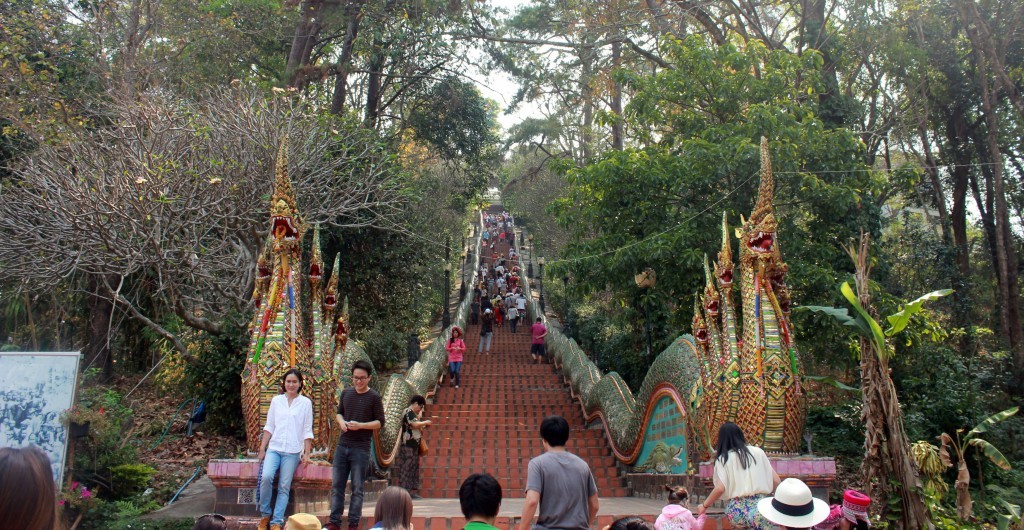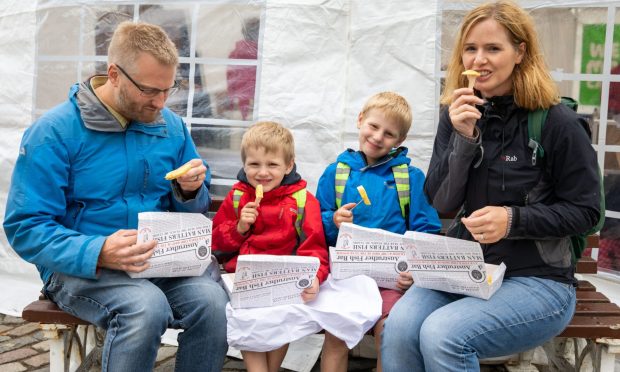Rivalling Bangkok as a city break destination, Chiang Mai is full of hidden surprises, says Katie Wright
Most Brits heading to Thailand usually arrive in Bangkok and promptly board a plane south in search of sandy shores and blue seas.
But just an hour’s flight north of the capital is an exciting city-break destination worth seeking out.
Once the heart of the ancient Lanna kingdom, Chiang Mai is home to a mix of stunning mountainous scenery, historic sights and tasty cuisine.
The square, walled old town is packed with temples or ‘wats’, but the most impressive one of all is found at the end of an incredibly snaky drive up a neighbouring hillside, followed by a short, steep funicular ride.
Wat Phrathat Doi Suthep was built here because it’s believed this is where a white elephant carrying some of Buddha’s ashes chose to stop some 600 years ago.
I climb the 300-plus steps of the temple’s Naga stairway, although sadly I’m unable to test the legend that if a betrothed couple walk up the stairs silently together and count the same number of steps, their love will last forever.
Against a backdrop of buzzing cicadas, the wat’s hilltop complex echoes with the clanging of bells – rung for good luck – that surround the ornate golden-roofed main temple.
Back at sea-level, the old town is small enough to walk around, but for journeys further afield, you’ve got to try Chiang Mai’s unique method of transport – the bright red ‘songthaew’ trucks that seat about 10 across two rows.
Flag one down and, if it’s already got passengers, see if they’re going in the right direction, then barter until you’re happy with the price. Most journeys shouldn’t cost more than 20 baht per person (less than 50p).
Thailand’s famous tuktuks are slightly more expensive, but careering wildly through the streets on these surprisingly speedy three-wheelers is a whole lot of fun and should be experienced at least once.
It’s a tuktuk that delivers me to a bend on the Ping river, where the city’s best nightlife is said to be found.
The Good View and Riverside bars are where young Chiang Maians head to let off steam and sink a few Chang beers while dancing to live music, but for something a little more sedate, Deck 1 offers cocktails on a pretty terrace overlooking the river.
For late-night eats, you’re never far from a street-side vendor, and you may be relieved to learn that northern provincial food tends to be a little less spicy than other regions.
But, as with everything in this vibrant city, it’s no less flavoursome.
WHERE TO STAY
:: Tamarind Village, www.tamarindvillage.com
Nestled in the middle of Chiang Mai’s bustling old town, Tamarind Village is built around the huge 200-year-old tree after which it’s named. The wide leafy canopy provides much needed shade and seclusion. Faithful to the traditional northern Lanna style, the boutique property’s 46 rooms are spread over a series of two-storied ivory buildings with dark, sloping roofs. The decor, too, reflects the local area: lacquered rattan and tribal furnishings sit comfortably alongside polished floors and contemporary pieces – a chic mix of heritage and elegance. With its own swimming pool, spa and restaurant offering Thai classics and international cuisine, the Village has plenty to keep you occupied.
WHERE TO EAT
:: The Service 1921,
chiang-mai.anantara.com/the-service-1921-restaurant-bar/
People tend to eat early in Thailand, with kitchens commonly closing not long after 9pm, but street-food stalls can be found dishing out specialities like pad krapao (spicy ground pork stir fried with holy basil) around the clock.
In search of something a little more refined? Head to the Anantara resort, where you’ll find the colonial house that was once Chiang Mai’s British Consulate. Inspired by the property’s heritage, The Service 1921 restaurant has an old school espionage vibe and private dining ‘war room’ concealed behind a bookcase.
WHAT TO DO
:: Chiang Mai’s night bazaar is a shopaholic’s dream, but the best bargains can be found at the weekend market, which starts at the Tha Phae Gate and runs approximately 1km down Ratchadamnoen Road. The weekend traders offer many of the same wares as the more famous nightly marketplace – handicrafts, jewellery, locally made silk clothing, designer knock-offs and every elephant themed trinket you can imagine – but at better prices. Bartering is encouraged (unless prices are displayed), but if you start with the view that everyone is trying to rip you off, you’ll get stressed very quickly. You can still strike a good deal while remaining calm – in fact, it helps. This is the Land of Smiles after all.
TRAVEL FACTS
:: Katie Wright was a guest of Hayes and Jarvis (01293 735831; www.hayesandjarvis.co.uk) who offers an 11-night trip to Thailand, taking in Chiang Mai and Phuket, from £899 per person – saving up to £339. The holiday includes three nights at the four-star Tamarind Village in Chiang Mai on a B&B basis, followed by an eight-night stay at the four-star Patong Beach Hotel, internal flights and return international flights from London Heathrow with Thai Airways. Based on departures September 11, 2016.












